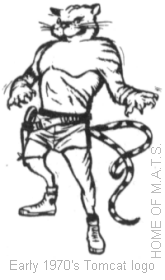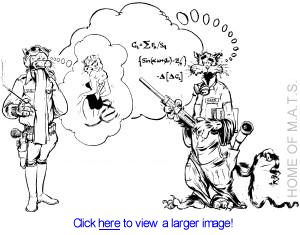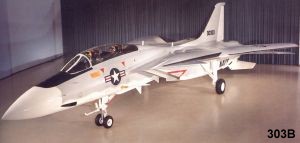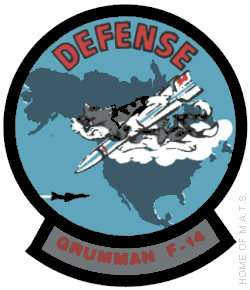
|
F-14A: The Beginning In 1968 the F-14 program was born with the Navy's proposal for the VFX (Navy Fighter Experimental) and resulted in Grumman's general design 303 (see below). The VFX required a
fighter with a two-man crew with tandem seating, two engines, an advanced weapon system with a
powerful radar plus the ability to carry a variety of long-, medium- and short-range
high-performance air-to-air missiles and an internal gun. Furthermore, the VFX should be able to
land on a carrier with a full armament load (if one considers the costs of todays weapons quite
a reasonable requirement!). In 1968 the F-14 program was born with the Navy's proposal for the VFX (Navy Fighter Experimental) and resulted in Grumman's general design 303 (see below). The VFX required a
fighter with a two-man crew with tandem seating, two engines, an advanced weapon system with a
powerful radar plus the ability to carry a variety of long-, medium- and short-range
high-performance air-to-air missiles and an internal gun. Furthermore, the VFX should be able to
land on a carrier with a full armament load (if one considers the costs of todays weapons quite
a reasonable requirement!).
Years before anybody thought of developing the F-14, in the early 1960's the US Navy and US Air Force had planned to build a fighter that should meet the requirements of both the Navy and the Air Force: The F-111. The Navy version was the F-111B, nicknamed "Sea Pig" by Navy crews and test personnel, an 85,000 lbs experimental fighter aircraft that was build to carry the 1,000 lbs heavy AIM-54 Phoenix missile and the AWG-9 radar. Missile and radar were a unique composition to shoot down aerial enemy targets 100 miles away. F-111B flight tests were not successful and killed several pilots. The aircraft was too heavy, too clumsy, too much a maintanance nightmare. Only 7 F-111B were produced before the program had been canceled in 1968. The AWG-9 radar and Phoenix missile would be installed in the F-111B replacement aircraft, the F-14A Tomcat. The Navy and Hughes decided to continue testing the AWG-9/Phoenix with the F-111B prototypes to ensure that the system was ready when the Tomcat was ready to fly years later.  As an incentive for the contractor to fullfill the requirements, the
Navy put some penalties on the project if Grumman would fail on some of the contract guarantees: As an incentive for the contractor to fullfill the requirements, the
Navy put some penalties on the project if Grumman would fail on some of the contract guarantees:
With this background and a good deal of knowledge on building Navy fighter aircraft, Grumman succeeded in delivering the F-14 on time, on cost and as an even better fighter than they contracted for! This is what the F-14 could have looked like ... Early Grumman general configuration models of what could have become the Tomcat:   During the design process, some 9,000 hours of wind-tunnel testing were performed on some 2,000 different configurations and nearly 400 combinations of air inlets and exhaust nozzles! In 1968 the design studies of the Grumman engineers concentrated on 8 layouts before the E version became the winning design (See table below). Thoughts during the design process incorporated the behaviour during high speed (supersonic) flight, supersonic combat ceiling performance, trouble-free engine performance, engine growth potential and subsonic longitudinal stability. The fixed-wing version was rejected because of its weight, carrier suitability and because of its low-altitude performance. Some of the basic design background for the F-14 (and also for the F-111) was gathered using a German x-plane which was built during 1944! Click here to read more about it and view some photos of this test aircraft.  



 When the initial design 303E was accepted, further improvements were made in the next design
steps:
When the initial design 303E was accepted, further improvements were made in the next design
steps:
 The first flight of the #1 prototype F-14A took place on December 21, 1970. All in all, fourteen aircraft were used for the development programm, 12 of them instrumented. Of those 12, two were used for the development of the Hughes Phoenix Missile System at Hughes Aircraft
Corporation at Point Mugu, CA. Six aircraft were used for airframe/engine testing at the Grumman
facilities at Calverton, NY and four for avionic system development at Pt. Mugu. Five F-14s (of
the six "airframe" aircraft) spent some time at Patuxent River, Maryland for carrier suitability
trials and for structural, powerplant and performance demonstration. The fully proven F-14 was
introduced to the fleet only 51 month after contract award!
The first flight of the #1 prototype F-14A took place on December 21, 1970. All in all, fourteen aircraft were used for the development programm, 12 of them instrumented. Of those 12, two were used for the development of the Hughes Phoenix Missile System at Hughes Aircraft
Corporation at Point Mugu, CA. Six aircraft were used for airframe/engine testing at the Grumman
facilities at Calverton, NY and four for avionic system development at Pt. Mugu. Five F-14s (of
the six "airframe" aircraft) spent some time at Patuxent River, Maryland for carrier suitability
trials and for structural, powerplant and performance demonstration. The fully proven F-14 was
introduced to the fleet only 51 month after contract award!
 Day 1, First Flight!
Day 1, First Flight!
The photograph (click on it to view larger format picture!) shows #1 prototype shortly before its maiden flight on December 21st 1970. Pilot was Grumman chief test pilot Robert Smythe with project test pilot William Miller in the back seat. The first flight was made very late in the day, sometime around 4 P.M. In December on the East Coast of the US, it gets dark early, and by 5 PM it's night-time. When #1 flew, the weather wasn't the greatest either; marginal at best. Grumman needed to get first flight accomplished by the end of 1970 or else end up paying the Navy a fine for breach of contract (see above). With Christmas approaching, Grumman knew that many people will start using their vacation time to extend their Christmas Holiday. So it was a "now or never" feeling at Calverton! On 30 December 1970, on the aircraft's second flight, the #1 Tomcat was lost due to failure of a hydraulic pump which caused a total loss of flight controls. The crew managed to eject safely and the aircraft crashed short of the runway at Grumman's Calverton facilities in New York. Thereafter flight testing began:
| ||||||||||||||||||||||||||||||||
Top of the page |
F-14 Tomcat History: Photos of early testing and production | Export Tomcats | F-14B: The next step | F-14D: The best ever Grumman proposals for the future | Today & Tomorrow | F-14 Combat Records The last F-14 catshot | The Final F-14 Flight Event F-14 Tomcat: Other Topics: Start Page Foreword FAQ Updates Copyright © by Torsten Anft |





